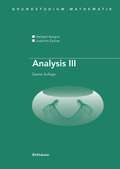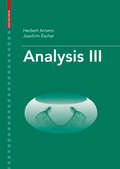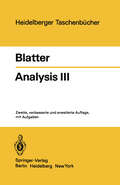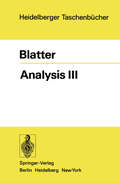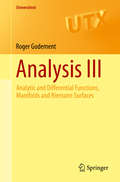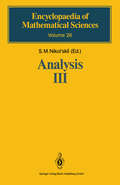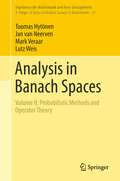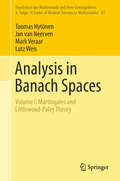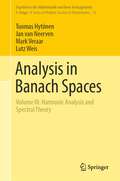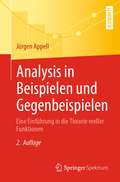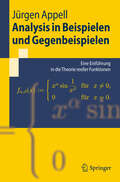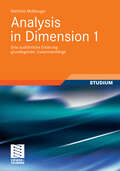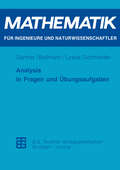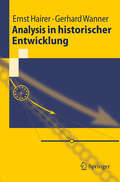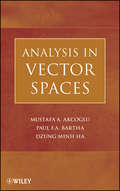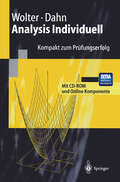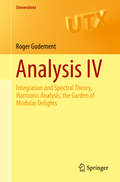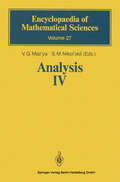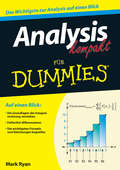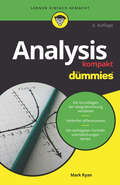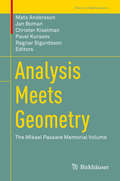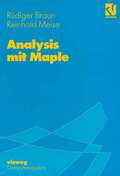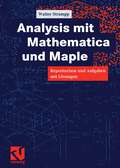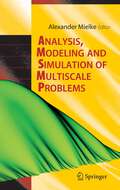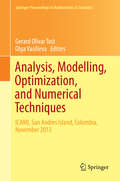- Table View
- List View
Analysis III (Grundstudium Mathematik)
by Herbert Amann Joachim EscherDer dritte und letzte Band dieser Reihe ist der Integrationstheorie und den Grundlagen der globalen Analysis gewidmet. Klarer Aufbau, eine strukturierte Darstellung der Theorie und zahlreiche Beispiele sowie konkrete Rechnungen und Übungsaufgaben erleichtern die Einübung des Stoffes. Sie machen dieses Lehrbuch zu einem verlässlichen Begleiter durch das gesamte Studium. Die Autoren geben ihren Lesern geeignete Werkzeuge für die weitere Beschäftigung mit der Mathematik an die Hand und liefern zahlreiche Ausblicke auf weiterführende Theorien.
Analysis III
by Herbert Amann Joachim EscherThis third volume concludes our introduction to analysis, wherein we ?nish laying the groundwork needed for further study of the subject. As with the ?rst two, this volume contains more material than can treated in a single course. It is therefore important in preparing lectures to choose a suitable subset of its content; the remainder can be treated in seminars or left to independent study. For a quick overview of this content, consult the table of contents and the chapter introductions. Thisbookisalsosuitableasbackgroundforothercoursesorforselfstudy. We hope that its numerous glimpses into more advanced analysis will arouse curiosity and so invite students to further explore the beauty and scope of this branch of mathematics. In writing this volume, we counted on the invaluable help of friends, c- leagues, sta?, and students. Special thanks go to Georg Prokert, Pavol Quittner, Olivier Steiger, and Christoph Walker, who worked through the entire text cr- ically and so helped us remove errors and make substantial improvements. Our thanks also goes out to Carlheinz Kneisel and Bea Wollenmann, who likewise read the majority of the manuscript and pointed out various inconsistencies. Without the inestimable e?ortofour “typesetting perfectionist”, this volume could not have reached its present form: her tirelessness and patience with T X E and other software brought not only the end product, but also numerous previous versions,to a high degree of perfection. For this contribution, she has our greatest thanks.
Analysis III (Heidelberger Taschenbücher #153)
by C. Blatter3 Für die Funktion f(x,y,=):= 1 zum Beispiel hat (1) den Wert (47t/3)R , (2) aber 2 den Wert R·27t·7t=27t R. Um den wahren Sachverhalt zu ergründen, betrachten wir für ein großes, aber festes seIN die im Innern von Q enthaltenen s-Würfel I". s und bezeichnen sie mit *1 (1 :!;,j:!;,N). Die durch (251. 2) definierte Abbildung g: u:=(r,qJ,. 9)-x:=(x,y,z) führt jeden Würfel W bijektiv in ein krummlinig begrenztes "Klötzchen" AcB • j j 3 R über (siehe die Fig. 252. 1). Diese Klötzchen bilden zusammen ein die Kugel B • 3 R von innen approximierendes Klötzchengebäude, somit gilt (wir verwenden wie derum das Zeichen == für "ungefähr gleich"): Es sei u das Zentrum des Würfels W und xj:=g(uj)eA . Wir wollen annehmen, j j j die Funktion f sei stetig; dann dürfen wir weiter schreiben Nun ist g differenzierbar und W "klein", somit ist j g(U) == g(U)+ g. (u)(u-u) eine für alle ue W brauchbare Approximation. Hiernach ist das Klötzchen j A j = g(W) in erster Näherung ein Parallelepiped, das durch Verzerrung des j Würfels *1 mit der linearen Abbildung g. (u) entstanden ist. Aufgrund von Satz (23. 22) gilt daher Fig. 252. 1 88 25. Variablentransformation bei mehrfachen Integralen so daß wir anstelle von (4) erhalten: (5) J,jJ(x)dJ1. x == f(x) Idetg*(u )IJ1. (W) j = ](u) IJ(u)IJ1.
Analysis III: Analytic and Differential Functions, Manifolds and Riemann Surfaces (Universitext)
by Roger GodementVolume III sets out classical Cauchy theory. It is much more geared towards its innumerable applications than towards a more or less complete theory of analytic functions. Cauchy-type curvilinear integrals are then shown to generalize to any number of real variables (differential forms, Stokes-type formulas). The fundamentals of the theory of manifolds are then presented, mainly to provide the reader with a "canonical'' language and with some important theorems (change of variables in integration, differential equations). A final chapter shows how these theorems can be used to construct the compact Riemann surface of an algebraic function, a subject that is rarely addressed in the general literature though it only requires elementary techniques.Besides the Lebesgue integral, Volume IV will set out a piece of specialized mathematics towards which the entire content of the previous volumes will converge: Jacobi, Riemann, Dedekind series and infinite products, elliptic functions, classical theory of modular functions and its modern version using the structure of the Lie algebra of SL(2,R).
Analysis III: Spaces of Differentiable Functions (Encyclopaedia of Mathematical Sciences #26)
by S. M. Nikol'SkiiIn the Part at hand the authors undertake to give a presentation of the historical development of the theory of imbedding of function spaces, of the internal as well as the externals motives which have stimulated it, and of the current state of art in the field, in particular, what regards the methods employed today. The impossibility to cover all the enormous material connected with these questions inevitably forced on us the necessity to restrict ourselves to a limited circle of ideas which are both fundamental and of principal interest. Of course, such a choice had to some extent have a subjective character, being in the first place dictated by the personal interests of the authors. Thus, the Part does not constitute a survey of all contemporary questions in the theory of imbedding of function spaces. Therefore also the bibliographical references given do not pretend to be exhaustive; we only list works mentioned in the text, and a more complete bibliography can be found in appropriate other monographs. O.V. Besov, v.1. Burenkov, P.1. Lizorkin and V.G. Maz'ya have graciously read the Part in manuscript form. All their critical remarks, for which the authors hereby express their sincere thanks, were taken account of in the final editing of the manuscript.
Analysis in Banach Spaces: Volume II: Probabilistic Methods and Operator Theory (Ergebnisse der Mathematik und ihrer Grenzgebiete. 3. Folge / A Series of Modern Surveys in Mathematics #67)
by Tuomas Hytönen Jan Van Neerven Mark Veraar Lutz WeisThis second volume of Analysis in Banach Spaces, Probabilistic Methods and Operator Theory, is the successor to Volume I, Martingales and Littlewood-Paley Theory. It presents a thorough study of the fundamental randomisation techniques and the operator-theoretic aspects of the theory. The first two chapters address the relevant classical background from the theory of Banach spaces, including notions like type, cotype, K-convexity and contraction principles. In turn, the next two chapters provide a detailed treatment of the theory of R-boundedness and Banach space valued square functions developed over the last 20 years. In the last chapter, this content is applied to develop the holomorphic functional calculus of sectorial and bi-sectorial operators in Banach spaces. Given its breadth of coverage, this book will be an invaluable reference to graduate students and researchers interested in functional analysis, harmonic analysis, spectral theory, stochastic analysis, and the operator-theoretic approach to deterministic and stochastic evolution equations.
Analysis in Banach Spaces: Volume I: Martingales and Littlewood-Paley Theory (Ergebnisse der Mathematik und ihrer Grenzgebiete. 3. Folge / A Series of Modern Surveys in Mathematics #63)
by Tuomas Hytönen Jan van Neerven Mark Veraar Lutz WeisThe present volume develops the theory of integration in Banach spaces, martingales and UMD spaces, and culminates in a treatment of the Hilbert transform, Littlewood-Paley theory and the vector-valued Mihlin multiplier theorem. Over the past fifteen years, motivated by regularity problems in evolution equations, there has been tremendous progress in the analysis of Banach space-valued functions and processes. The contents of this extensive and powerful toolbox have been mostly scattered around in research papers and lecture notes. Collecting this diverse body of material into a unified and accessible presentation fills a gap in the existing literature. The principal audience that we have in mind consists of researchers who need and use Analysis in Banach Spaces as a tool for studying problems in partial differential equations, harmonic analysis, and stochastic analysis. Self-contained and offering complete proofs, this work is accessible to graduate students and researchers with a background in functional analysis or related areas.
Analysis in Banach Spaces: Volume III: Harmonic Analysis and Spectral Theory (Ergebnisse der Mathematik und ihrer Grenzgebiete. 3. Folge / A Series of Modern Surveys in Mathematics #76)
by Tuomas Hytönen Jan van Neerven Mark Veraar Lutz WeisThis third volume of Analysis in Banach Spaces offers a systematic treatment of Banach space-valued singular integrals, Fourier transforms, and function spaces. It further develops and ramifies the theory of functional calculus from Volume II and describes applications of these new notions and tools to the problem of maximal regularity of evolution equations. The exposition provides a unified treatment of a large body of results, much of which has previously only been available in the form of research papers. Some of the more classical topics are presented in a novel way using modern techniques amenable to a vector-valued treatment. Thanks to its accessible style with complete and detailed proofs, this book will be an invaluable reference for researchers interested in functional analysis, harmonic analysis, and the operator-theoretic approach to deterministic and stochastic evolution equations.
Analysis in Beispielen und Gegenbeispielen: Eine Einführung in die Theorie reeller Funktionen
by Jürgen AppellDas Buch führt in die Theorie der reellen Funktionen einer und mehrerer Variablen ein. Im Vordergrund stehen weniger abstrakte Ergebnisse als vielmehr die zahlreichen Beispiele und Gegenbeispiele, anhand derer die Bedeutung mathematischer Sätze deutlich gemacht wird. Kapitel 1 – 3 sind den wesentlichen Ergebnissen über stetige, differenzierbare und integrierbare Funktionen gewidmet, Kapitel 4 geht mit „merkwürdigen" Teilmengen der reellen Achse etwas über den üblichen Stoff hinaus. Funktionen mehrerer Variablen werden in Kapitel 5 bzw. 6 behandelt.
Analysis in Beispielen und Gegenbeispielen: Eine Einführung in die Theorie reeller Funktionen (Springer-Lehrbuch)
by Jürgen AppellDas Buch führt in die Theorie der reellen Funktionen einer und mehrerer Variablen ein. Im Vordergrund stehen weniger abstrakte Ergebnisse als vielmehr die zahlreichen Beispiele und Gegenbeispiele, anhand derer die Bedeutung mathematischer Sätze deutlich gemacht wird. Kapitel 1 – 3 sind den wesentlichen Ergebnissen über stetige, differenzierbare und integrierbare Funktionen gewidmet, Kapitel 4 geht mit „merkwürdigen" Teilmengen der reellen Achse etwas über den üblichen Stoff hinaus. Funktionen mehrerer Variablen werden in Kapitel 5 bzw. 6 behandelt.
Analysis in Dimension 1: Eine ausführliche Erklärung grundlegender Zusammenhänge
by Matthias MoßburgerAnalysis in Fragen und Übungsaufgaben (Mathematik für Ingenieure und Naturwissenschaftler, Ökonomen und Landwirte)
by Karl-Heinz Gärtner Margitta Bellmann Werner Lyska Roland SchmiederAnalysis in historischer Entwicklung (Springer-Lehrbuch)
by Ernst Hairer Gerhard WannerDiese Einführung in die Analysis orientiert sich an der historischen Entwicklung: Die ersten zwei Kapitel schlagen den Bogen von historischen Berechnungsmethoden zu unendlichen Reihen, zur Differential- und Integralrechnung und zu Differentialgleichungen. Die Etablierung einer mathematisch stringenten Denkhaltung im 19. Jahrhundert für ein und mehrere Variablen ist Thema der darauffolgenden Kapitel. Viele Beispiele, Berechnungen und Bilder machen den Band zu einem Lesevergnügen – für Studierende, für Lehrer und für Wissenschaftler.
Analysis in Vector Spaces
by Mustafa A. Akcoglu Paul F. Bartha Dzung Minh HaA rigorous introduction to calculus in vector spaces The concepts and theorems of advanced calculus combined with related computational methods are essential to understanding nearly all areas of quantitative science. Analysis in Vector Spaces presents the central results of this classic subject through rigorous arguments, discussions, and examples. The book aims to cultivate not only knowledge of the major theoretical results, but also the geometric intuition needed for both mathematical problem-solving and modeling in the formal sciences. The authors begin with an outline of key concepts, terminology, and notation and also provide a basic introduction to set theory, the properties of real numbers, and a review of linear algebra. An elegant approach to eigenvector problems and the spectral theorem sets the stage for later results on volume and integration. Subsequent chapters present the major results of differential and integral calculus of several variables as well as the theory of manifolds. Additional topical coverage includes: Sets and functions Real numbers Vector functions Normed vector spaces First- and higher-order derivatives Diffeomorphisms and manifolds Multiple integrals Integration on manifolds Stokes' theorem Basic point set topology Numerous examples and exercises are provided in each chapter to reinforce new concepts and to illustrate how results can be applied to additional problems. Furthermore, proofs and examples are presented in a clear style that emphasizes the underlying intuitive ideas. Counterexamples are provided throughout the book to warn against possible mistakes, and extensive appendices outline the construction of real numbers, include a fundamental result about dimension, and present general results about determinants. Assuming only a fundamental understanding of linear algebra and single variable calculus, Analysis in Vector Spaces is an excellent book for a second course in analysis for mathematics, physics, computer science, and engineering majors at the undergraduate and graduate levels. It also serves as a valuable reference for further study in any discipline that requires a firm understanding of mathematical techniques and concepts.
Analysis Individuell: Kompakt zum Prüfungserfolg
by Helmut Wolter Bernd I. DahnEin Lehrbuch - drei Komponenten! Die gedruckte Version bietet ein bisher einzigartiges Repetitorium zur Grundvorlesung Analysis. Es umfaßt in strukturierter und sich auf das Wesentliche beschränkende Form den Stoff, das Basiswissen für Vordiplom und Zwischenprüfungen Die beigefügte CD-ROM enthält das vollständige Lehrbuch mit ausführlichen Beweisen und Detailwissen, welches das Repetitorium ergänzt. Mit der auf der CD-ROM ebenfalls enthaltenen Zugangsberechtigung kann via Internet das auf einem Server liegende Buch nach individuellen Wissensbedürfnissen konfiguriert werden. Diese ideal auf die Kundenbedürfnisse abgestimmte Strategie zwischen Print, Off-line und On-line Version ist weltweit einzigartig.
Analysis IV: Integration and Spectral Theory, Harmonic Analysis, the Garden of Modular Delights (Universitext)
by Roger GodementAnalysis Volume IV introduces the reader to functional analysis (integration, Hilbert spaces, harmonic analysis in group theory) and to the methods of the theory of modular functions (theta and L series, elliptic functions, use of the Lie algebra of SL2). As in volumes I to III, the inimitable style of the author is recognizable here too, not only because of his refusal to write in the compact style used nowadays in many textbooks. The first part (Integration), a wise combination of mathematics said to be `modern' and `classical', is universally useful whereas the second part leads the reader towards a very active and specialized field of research, with possibly broad generalizations.
Analysis IV: Linear and Boundary Integral Equations (Encyclopaedia of Mathematical Sciences #27)
by V.G. Maz'yaA linear integral equation is an equation of the form XEX. (1) 2a(x)cp(x) - Ix k(x, y)cp(y)dv(y) = f(x), Here (X, v) is a measure space with a-finite measure v, 2 is a complex parameter, and a, k, f are given (complex-valued) functions, which are referred to as the coefficient, the kernel, and the free term (or the right-hand side) of equation (1), respectively. The problem consists in determining the parameter 2 and the unknown function cp such that equation (1) is satisfied for almost all x E X (or even for all x E X if, for instance, the integral is understood in the sense of Riemann). In the case f = 0, the equation (1) is called homogeneous, otherwise it is called inhomogeneous. If a and k are matrix functions and, accordingly, cp and f are vector-valued functions, then (1) is referred to as a system of integral equations. Integral equations of the form (1) arise in connection with many boundary value and eigenvalue problems of mathematical physics. Three types of linear integral equations are distinguished: If 2 = 0, then (1) is called an equation of the first kind; if 2a(x) i= 0 for all x E X, then (1) is termed an equation of the second kind; and finally, if a vanishes on some subset of X but 2 i= 0, then (1) is said to be of the third kind.
Analysis kompakt fur Dummies (Für Dummies)
by Mark RyanAn der Analysis kommen Sie nicht vorbei: Sei es nun in der Schule oder wenn Sie Natur-, Ingenieurs-, oder Wirtschaftswissenschaften studieren. Dieses Buch hilft Ihnen, wenn Sie sich einen schnellen Überblick über das Thema verschaffen wollen. Mark Ryan erklärt Ihnen leicht verständlich, was Sie über Grenzwerte und Funktionen unbedingt wissen sollten. So ist dies Ihr perfekter Nachhilfelehrer für die Tasche: freundlich, kompetent, günstig.
Analysis kompakt für Dummies (Für Dummies)
by Mark RyanAn der Analysis kommen Sie nicht vorbei: Sei es nun in der Schule oder wenn Sie Natur-, Ingenieurs- oder Wirtschaftswissenschaften studieren. Dieses Buch hilft Ihnen, wenn Sie sich einen schnellen Überblick über das Thema verschaffen wollen. Mark Ryan erklärt Ihnen leicht verständlich, was Sie über Grenzwerte, Ableitungen und Integrale unbedingt wissen sollten. Übungsaufgaben helfen Ihnen dabei, das Gelernte zu verinnerlichen. So ist dies Ihr perfekter Nachhilfelehrer für die Tasche: freundlich, kompetent, günstig.
Analysis Meets Geometry: The Mikael Passare Memorial Volume (Trends in Mathematics)
by Mats Andersson Jan Boman Christer Kiselman Pavel Kurasov Ragnar SigurdssonThis book is dedicated to the memory of Mikael Passare, an outstanding Swedish mathematician who devoted his life to developing the theory of analytic functions in several complex variables and exploring geometric ideas first-hand. It includes several papers describing Mikael’s life as well as his contributions to mathematics, written by friends of Mikael’s who share his attitude and passion for science. A major section of the book presents original research articles that further develop Mikael’s ideas and which were written by his former students and co-authors. All these mathematicians work at the interface of analysis and geometry, and Mikael’s impact on their research cannot be underestimated. Most of the contributors were invited speakers at the conference organized at Stockholm University in his honor. This book is an attempt to express our gratitude towards this great mathematician, who left us full of energy and new creative mathematical ideas.
Analysis mit Maple
by Rüdiger Braun Reinhold MeiseDer Aufbau des Buches orientiert sich an dem Standardwerk zur Analysis 1 und 2 von O. Forster.
Analysis, Modeling and Simulation of Multiscale Problems
by Alexander MielkeThis book reports recent mathematical developments in the Programme "Analysis, Modeling and Simulation of Multiscale Problems", which started as a German research initiative in 2006. Multiscale problems occur in many fields of science, such as microstructures in materials, sharp-interface models, many-particle systems and motions on different spatial and temporal scales in quantum mechanics or in molecular dynamics. The book presents current mathematical foundations of modeling, and proposes efficient numerical treatment.
Analysis, Modelling, Optimization, and Numerical Techniques: ICAMI, San Andres Island, Colombia, November 2013 (Springer Proceedings in Mathematics & Statistics #121)
by Gerard Olivar Tost Olga VasilievaThis book highlights recent compelling research results and trends in various aspects of contemporary mathematics, emphasizing applicabilitions to real-world situations. The chapters present exciting new findings and developments in situations where mathematical rigor is combined with common sense. A multi-disciplinary approach, both within each chapter and in the volume as a whole, leads to practical insights that may result in a more synthetic understanding of specific global issues as well as their possible solutions. The volume will be of interest not only to experts in mathematics, but also to graduate students, scientists, and practitioners from other fields including physics, biology, geology, management, and medicine.
